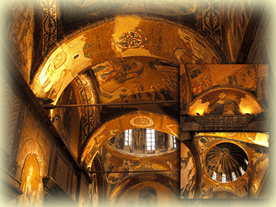|
|
|
|
|
|
About the Style of SEM's Choir

General notes on the SEM Choir's style and composers
|
|
The style of SEM's choir also known as the Mount Lebanon choir is known for its following characteristics. It is:
|
|
1. An Ornamented Style
SEM is the first official choir in Antioch who performed developed musical ornamentations. The choir's style is known to be highly majestic and ornamented and sometimes prolonged. This is due to the main preaching goal of SEM's concerts (check in this website SEM's Strategy) that are recorded and published to the public.
In daily services, in general, SEM chanters or small groups of SEM chanters perform shorter versions of the known recorded chants. In parish normal services, SEM encourages fast tempo in chanting and short (but original) versions of chants.
The audience of concerts is totally different from the audience in the services. The aim of the choir in concerts is basically to impress its audience and let it feel the spiritual treasures of Byzantine Music. In services, you are obliged to follow the specified Typicon program where Matins and Liturgy are already long services and daily Vespers is not meant to stay for a long time since it is a daily service - On feasts, services should be majestic of course - So, parishes' people prefer not to stay for a long time in the services though the program is long; accordingly, the chanter should be fast and at the same time he should leave the best possible impression, not for him to be praised, but for the service to be wonderful to retain the audience and make them pray.
In general, normal chants and Kirie Eleison should be fast, and Doxas and Papadik chants should go slowly.
|
|
2. A Diversified Style
SEM does not stick to a specific style in Byzantine Chanting. This is normally not the right choice for a professional Byzantine choir. Yet, SEM had this choice because it has a great value for the interests of the church:
SEM is the choir of the Archdiocese which means that it is formed by the chanters of the parishes of the Archdiocese, and each of these chanters directs the choir of his parish. Accordingly, if all those chanters were oriented toward the same style in chanting, then all parishes' choirs will have the same style. On the other hand, each of these choirs presents a concert (at least) on occasions.
So, if we want to have an interesting Byzantine Music ambiance in the Archdiocese, we will have to diversify the styles of the concerts that are been delivered at the same occasions. In other words, if all choirs (concerts) interpret exactly the same style, this means that the audience at Easter for example will be satisfied by attending only one concert; since this concert will be representative of all the others. On the contrary, if each choir has its own style, then each concert will have its own flavor and atmosphere: Karas style, Mount Athos Style, Stanitsas Style, Oriental oriented style, etc. And accordingly, the audience will be interested in watching the maximum possible number of concerts, and he will search for the style that best matches with his mood. etc.
According to the logical basis shown above, we decided at SEM to follow a diversified combination of styles where we expose our chanters to a variety of styles and we push them to excel in all of them. Then we orient each chanter to the style that meets his music personality the most. Then the aim is that he focuses in his parish choir on that style.
|
|
3. A Conservative Style
On the other hand, it should be noted that the diversified styles do not include non Byzantine styles (Extreme Oriental styles, etc.). SEM is known for its conservative orientation: Only Byzantine Traditional Styles are performed.
On the other hand, it should be noted that the few polyphonic chants that were performed by the choir had a specific objective (check in this website: History of SEM's Recordings) and they were never performed in services.
|
|
4. A Research Open Style
SEM is known to compose and perform Byzantine Music in forms that were forgotten or rarely used in Arabic (Prolonged Melismatic, Prolonged Stachiraric, etc.).
|
|
|